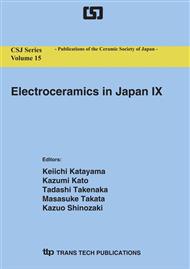p.121
p.127
p.131
p.135
p.139
p.143
p.147
p.151
p.155
Size Dependence of Dielectric Properties for Barium Titanate Nanoparticles Prepared under Various Vacuum Atmospheres
Abstract:
Barium titanate (BaTiO3) fine particles were prepared using the 3-step thermal decomposition method of barium titanyl oxalate under various vacuum atmospheres. In this method, the first two steps prepared BaTiO3 nanoparticles with 30 nm, and at the 3rd step, BaTiO3 nanoparticles were heat-treated at various temperature and degree of vacuum. As a result, as degree of vacuum is high, particle size of BaTiO3 fine particles decreased. Moreover, the dielectric constant of BaTiO3 fine particles was measured using the powder dielectric measurement method with slurry. The dielectric constant of these particles showed the dielectric maximum of 4,320 at 200 nm despite degree of vacuum. This result revealed that degree of vacuum during particle growth of BaTiO3 particles had no relation about dielectric constant.
Info:
Periodical:
Pages:
139-142
Citation:
Online since:
September 2006
Price:
Сopyright:
© 2006 Trans Tech Publications Ltd. All Rights Reserved
Share:
Citation:


